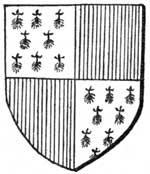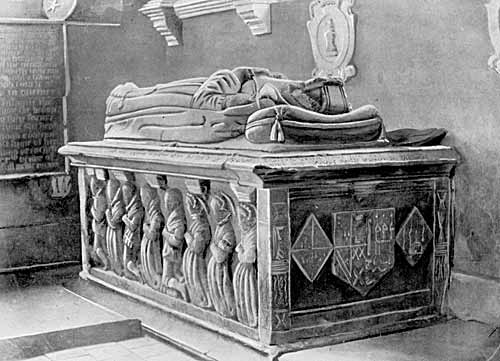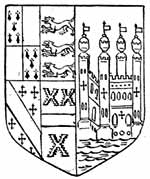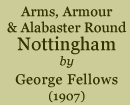< Radcliffe-on-Soar (contd.) | Contents | Stapleford >
St. Peter and St. Paul, Shelford.
 |
ARMS OF STANHOPE—Quarterly ermine and gules. |
THE Stanhopes became owners in Nottinghamshire by the marriage, in the 14th Century, of Sir John Stanhope, of Northumberland, with Elizabeth, daughter and heir of Stephen Manlovel, or Malluvel, of Rampton, co. Notts. In November, 1538, King Henry VIII., by Letters Patent, granted the house and site of the Priory of Shelford, together with considerable land, to Michael Stanhope, Esquire (subsequently created a Knight), and Anne, his wife, and his heirs. This gift was followed a few years subsequently by a still further grant of Manors in various parts of the County, that had formerly belonged to the Monastery of Shelford. It is not surprising, therefore, that Dr. Thoroton should remark that this Michael Stanhope "left the beginning of a fair estate;" the King had made it easy for him to do so; and Camden says, "Shelford, the seat of the famous family of Stanhope, Knights, whose state and grandeur in these parts is eminent and their names renowned."
The Church here has been so much restored that it is difficult to assign a date to its origin: there are examples of every style, from Early English onwards. In one of the restorations, however, the shaft of a cross was discovered, which an eminent authority has described as "intensely Scandinavian in character." The last restoration took place in 1877 at a cost of £3,000, chiefly contributed by the late Earl of Carnavon. It was at this time that the tombs, floor-stones, and mural tablets were concentrated in the place they now occupy, namely, in the Chesterfield Chapel at the east end of the south aisle, which is divided from the body of the Church by a parclose screen.
 |
Tomb of Lady Anne Stanhope at Shelford. |
Of this group, the most imposing is the Altar Tomb made of alabaster, on which lies the effigy of Lady Anne Stanhope, widow of Sir Michael. She was the daughter of Nicholas Rawson, of Aveley, Essex, and died on 20th February, 1587, having survived her husband 35 years. She presented him with a large family, viz., five sons and three daughters, besides two sons and one daughter, who died in infancy. The offspring are represented on the Altar base kneeling in a line: at the first glance there appear to be three sons and five daughters, but a closer inspection shows that two of the figures are intended to be sons clothed in the robes of the respective offices they held: on the east end of the tomb the three who died early are shown swathed in their grave clothes. From the inscription on a tablet near the tomb we learn that the sons were successful in life, and eventually attained to good positions. Sir Thomas was the heir; Edward, one of the Queen's Council for the North of England; John, a gentleman of the Privy Chamber to "our most deare Sovarigne ladie queene Elizabeth"; he was created Baron Stanhope of Harrington. Edward, Doctor of Civil Law and a Master of the High Court of Chancery, and Michael, one of the Privy Chamber to Queen Elizabeth. Three daughters married well, whilst Margaret, William, and Edward, died young; it will be seen from the above that three sons were named Edward! The inscription goes on to say that "she kept contynwallie a worshipfull house, releved the poore dealy .... spent the most tyme of her latter dayes in prayer, etc," She is represented as clothed in a loose outer robe with long cords, ending in tassels near her feet, a frill round her neck, puffed sleeves, a quadruple necklace, and a long chain carrying a pomander, but her countenance and hands have been apparently sawn off; this was probably a wantonly revengeful act on the part of the Cromwellians. At the west end of the Altar base are three shield of arms, viz., a large one in the centre showing Stanhope, quartering, Malluvel, vert, three greyhounds courant or, Longvillers sable, a bend between six crosses crosslet or (Dr. Thoroton states (p. 148) that "the family of Stanhope before used the coat of Lungvillers ") and . . . . a fesse between three saltires engrailed, impaling Rawson, gules, a four square castle in perspective with as many towers and cupolas, viz., one at each angle or, standing in water azure. This shield is flanked on either side by a lozenge bearing the arms of Stanhope and Rawson respectively. Sir Michael Stanhope was a second son, his mother being Avelina, daughter of Sir Gervase Clifton. His elder brother married Anne, daughter and co-heir of John Strelley, of Strelley. Sir Michael's half sister Anne married Edward Seymour, Duke of Somerset, Lord Protector, temp. Edward VI. He was appointed Governor of Hull, and Knighted by Henry VIII., and made chief gentleman of the Privy Chamber to Edward VI. He naturally benefited by his close relationship to so powerful and influential a nobleman as his half-brother, the Protector, but the conspiracy that caused the latter's downfall and subsequent execution also involved Sir Michael, for he was imprisoned in 1551, and shortly afterwards (25th February, 1552) shared the same fate as his relative on Tower Hill. The Stanhopes were staunch to the Royal cause and King Charles I. Sir Philip Stanhope was elevated to the Peerage as Baron Stanhope of Shelford, in 1616, and further advanced to the Earldom of Chesterfield in 1628. He garrisoned his house at Shelford for the King, and his son Philip lost his life in its defence, when it was taken by the Cromwellian forces and burnt to the ground. Colonel Michael Stanhope also was killed in the skirmish at Willoughby Field, and is there buried (1648); also Ferdinando (Philip's elder brother), Colonel of horse, fell fighting under the Royal banner at Bridgford in the year 1643. There is a legend that a party of Royalists occupied the Church tower, and from that advantageous position harrassed the Parliamentarians, who, failing to dislodge them, eventually had recourse to lighting straw in the base of the tower, and so ejected them.
The Chesterfield Chapel at Shelford contains several floor-stones and mural monuments to this distinguished family. The body of the Earl of Chesterfield, the author of "Letters to his son," is buried here, having been previously interred in London; there is, however, no separate tablet to him. Among others there is a floor-stone (now much defaced) to Beatrix Rawson, mother to Lady Anne Stanhope. There are also some funeral trappings and a banner.

